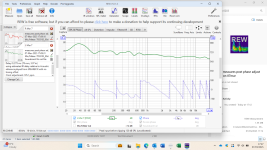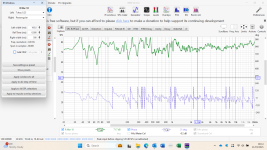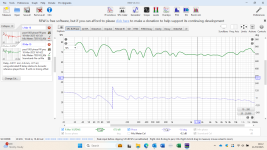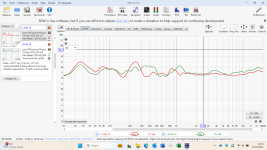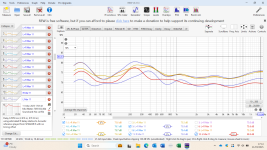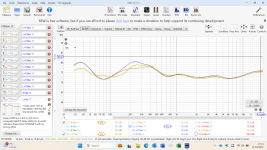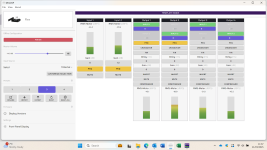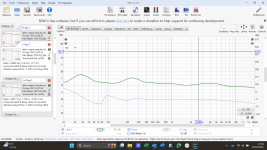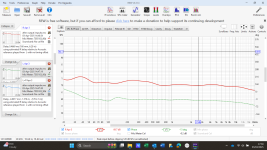Is the IR aligned at zero at the first big peak? That alone makes a world of difference in how the phase shows up.
I now went through the following process;
1. Measure with REW around the listening area (Rand L) and average
2. Prepare PEQ input filters with REW software
3. Take a single measurement (R and L) at the listening point with those filters in place
4. Prepare the measurements with IR shift to zero and FDW, vector average and export to Rephase
5. Minimise phase variance above 200Hz and FR as close to Harman curve as i can (particularly noting Rephase doesn't allow loading a target)
6. Export those FIR filters and load in the flex
7. Measure the result in REW at the same spot.
I then see the attached results, with and without FDW.
The frequency balance is clearly different to before and rising in the treble.
At the moment i am still trying to understand the expectations, likelihoods, priorities and process (now i have a computer working!) more than listen to the results.
I know the processor is not powerful enough to do phase below ~200Hz, even though in theory it will go nearer 100Hz, in practice it doesn't.
The frequency response i measure after applying the filters is quite different to the target curve i have matched, particularly the rising treble.
This is the right channel which has the more awkward reflections.
Phase is all over the place without the FDW.
If anyone is kind enough to comment it would all be greatly valued!
M
1. Measure with REW around the listening area (Rand L) and average
2. Prepare PEQ input filters with REW software
3. Take a single measurement (R and L) at the listening point with those filters in place
4. Prepare the measurements with IR shift to zero and FDW, vector average and export to Rephase
5. Minimise phase variance above 200Hz and FR as close to Harman curve as i can (particularly noting Rephase doesn't allow loading a target)
6. Export those FIR filters and load in the flex
7. Measure the result in REW at the same spot.
I then see the attached results, with and without FDW.
The frequency balance is clearly different to before and rising in the treble.
At the moment i am still trying to understand the expectations, likelihoods, priorities and process (now i have a computer working!) more than listen to the results.
I know the processor is not powerful enough to do phase below ~200Hz, even though in theory it will go nearer 100Hz, in practice it doesn't.
The frequency response i measure after applying the filters is quite different to the target curve i have matched, particularly the rising treble.
This is the right channel which has the more awkward reflections.
Phase is all over the place without the FDW.
If anyone is kind enough to comment it would all be greatly valued!
M
Attachments
You can't expect phase to not reflect the room you're in. That's why I advocate using the FDW (6 cycle) to see what happens early on. It somewhat protects you from over-correcting things. One thing that does not work is over-correction. Once you get the phase result you have now, focus on balance that does include a longer time frame.
I'll try and outline my way of working. If I see a good correlation between averages of multispot measurements and the single sweetspot measurements I let go of the multispot correction all together. I measure at sweetspot, left and right separately and correct what I can using a FDW (6 cycles). I measure to see if what I did works at that sweetspot (aligning the IR at zero) and making a simultanious L+R measurement. That should show a good sum that's higher than a left or right measurement by itself. All with that FDW (6 cycles) applied.
Once I'm happy with that, I go tweak overall balance. A new set of measurements or re-use the last set and apply a 20 cycle FDW. That's the one I use for EQ to follow something like the Harman curve as a start. Left and right separately, not looking for phase tweaks anymore, just good balance between both channels.
When I'm done with that, I'll fire up my favorite songs and listen. Maybe tweaking based on what I hear, but never based on a single song. Looking for balance trough listening takes time, lots of it and can be applied to left + right as overall tweak, we've already tweaked left/right balance separately.
The hardest part is that one side has more reflections than the other, that means it will alter whatever "stage" is present in the music. I've got some of that in my room. I can tweak it a little with my ambience speakers but it will never be completely gone. So I adjust it as best I can to be able to enjoy it. Absorption works well on close by Surfaces but I can't tell you what to do here.
Hope this helps.
I'll try and outline my way of working. If I see a good correlation between averages of multispot measurements and the single sweetspot measurements I let go of the multispot correction all together. I measure at sweetspot, left and right separately and correct what I can using a FDW (6 cycles). I measure to see if what I did works at that sweetspot (aligning the IR at zero) and making a simultanious L+R measurement. That should show a good sum that's higher than a left or right measurement by itself. All with that FDW (6 cycles) applied.
Once I'm happy with that, I go tweak overall balance. A new set of measurements or re-use the last set and apply a 20 cycle FDW. That's the one I use for EQ to follow something like the Harman curve as a start. Left and right separately, not looking for phase tweaks anymore, just good balance between both channels.
When I'm done with that, I'll fire up my favorite songs and listen. Maybe tweaking based on what I hear, but never based on a single song. Looking for balance trough listening takes time, lots of it and can be applied to left + right as overall tweak, we've already tweaked left/right balance separately.
The hardest part is that one side has more reflections than the other, that means it will alter whatever "stage" is present in the music. I've got some of that in my room. I can tweak it a little with my ambience speakers but it will never be completely gone. So I adjust it as best I can to be able to enjoy it. Absorption works well on close by Surfaces but I can't tell you what to do here.
Hope this helps.
Thanks as always, i do believe i am gradually learning and understanding more, it just may not seem so from the outside!!
One small one if i may, concerning Left to Right in timing relationship terms, which is what you are describing in the last two lines of para 2 i believe, how might one measure the timing of left to right and shift one appropriately?
I have channel delay in the Flex unit, i could i guess do it by trial and error, but i have probably measured it already in the sequence above and could apply that?
Meanwhile i simply experimented with delaying one channel in increments at .01ms up to 20ms, and took a screen shot of some of the results, shown with and without the individual channels, there is little effect above 500 HZ but quite a significant flattening of the hills below 500Hz, all in one microphone position, it may be that possible benefit goes away with different mic positions.........
M
One small one if i may, concerning Left to Right in timing relationship terms, which is what you are describing in the last two lines of para 2 i believe, how might one measure the timing of left to right and shift one appropriately?
I have channel delay in the Flex unit, i could i guess do it by trial and error, but i have probably measured it already in the sequence above and could apply that?
Meanwhile i simply experimented with delaying one channel in increments at .01ms up to 20ms, and took a screen shot of some of the results, shown with and without the individual channels, there is little effect above 500 HZ but quite a significant flattening of the hills below 500Hz, all in one microphone position, it may be that possible benefit goes away with different mic positions.........
M
Attachments
I've always measured in the exact sweet spot. How do you find it? Measure a stereo signal and observe the peaks. When nearly in the equal distance sweetspot, you'll see a big peak, often followed quickly by a smaller one. Next I just move the mic in small increments until I see one large peak. Usually takes me a couple of tries, sometimes even a bit tiresome but practice makes perfect.
Should work too if you're slightly off axis and use delay for the one channel that's closer. Due to having a very low level of early reflections I've been capable of getting an almost perfect +6dB sum of the L+R measurement when viewed with a 6 cycle FDW. But it highly depends on being in that exact sweetspot and having a low level of reflections in the frequency dependent window.
The IR of left and right compared in one of my old measurements:

(notice the low level of reflections in both channels)
This too is an old example of the sum of L+R being above the separate L and R measurements:

(you see it's not that exact below 300 Hz where the room rules what you get)
This cannot work perfectly in the presence of strong early reflections though, but viewing it with a 6 cycle FDW you'd have a shot of getting the sum well above the left and right separate measurements. For me it became easy to repeat as I'd use one session of measuring, making sure to be in the exact sweetspot and use DRC to make my FIR correction files and without moving the mic making these type of "control" measurements. It would take me a whole afternoon but I got better at it with practice.
But a quick work-around to check left vs right results is aligning both the measured results with the peak at zero in the IR and simply combine (sum) them using REW tools (using the FDW 6 cycle). No need to have measurements taken in the exact sweet spot to do it and you can still see how left and right compare. There's only one spot that combines like this under the right circumstances. Is it important? Well, for me it's always been a good way to verify what I was doing. But for listening it isn't that important at all. I'm not glued to the sweetspot with a laser on my forehead 😀. Our brain is quite capable to work with it, even when moving your head. How far one can move depends on a lot of factors but in my sweetspot I can swing my head side to side without ill effects. Say 10 cm each way without upsetting the stereo experience.
Measurements being 10 cm from the exact sweet spot would look way worse than what I've shown, but it doesn't sound way worse at all. So it's good to keep that in mind. Pretty pictures don't make pretty sounds per definition. Knowing/learning what to correct and what not to correct will make it sound better. Babysteps.
Should work too if you're slightly off axis and use delay for the one channel that's closer. Due to having a very low level of early reflections I've been capable of getting an almost perfect +6dB sum of the L+R measurement when viewed with a 6 cycle FDW. But it highly depends on being in that exact sweetspot and having a low level of reflections in the frequency dependent window.
The IR of left and right compared in one of my old measurements:
(notice the low level of reflections in both channels)
This too is an old example of the sum of L+R being above the separate L and R measurements:
(you see it's not that exact below 300 Hz where the room rules what you get)
This cannot work perfectly in the presence of strong early reflections though, but viewing it with a 6 cycle FDW you'd have a shot of getting the sum well above the left and right separate measurements. For me it became easy to repeat as I'd use one session of measuring, making sure to be in the exact sweetspot and use DRC to make my FIR correction files and without moving the mic making these type of "control" measurements. It would take me a whole afternoon but I got better at it with practice.
But a quick work-around to check left vs right results is aligning both the measured results with the peak at zero in the IR and simply combine (sum) them using REW tools (using the FDW 6 cycle). No need to have measurements taken in the exact sweet spot to do it and you can still see how left and right compare. There's only one spot that combines like this under the right circumstances. Is it important? Well, for me it's always been a good way to verify what I was doing. But for listening it isn't that important at all. I'm not glued to the sweetspot with a laser on my forehead 😀. Our brain is quite capable to work with it, even when moving your head. How far one can move depends on a lot of factors but in my sweetspot I can swing my head side to side without ill effects. Say 10 cm each way without upsetting the stereo experience.
Measurements being 10 cm from the exact sweet spot would look way worse than what I've shown, but it doesn't sound way worse at all. So it's good to keep that in mind. Pretty pictures don't make pretty sounds per definition. Knowing/learning what to correct and what not to correct will make it sound better. Babysteps.
I need to improve my understanding and feel for the timing aspects of the measurements, there is the start of the sweep, the impulse zero, FDW etc, currently these dont fall in place intuitively for me, so i struggle with some manipulations, more experiments will hopefully reduce that!
I am reading and reviewing the REW area describing the measurements to try and get a grasp!
M
I am reading and reviewing the REW area describing the measurements to try and get a grasp!
M
Take your time, it isn't always easy. An IR isn't guaranteed to look like the one I posted above, It only looks that great because it's been corrected with a FIR file.
If there's any early reflections happening thing become unclear much easier. So under those circumstances it is much harder to "see" timing differences between two channels. Learning REW and it's tools takes time too. If things sound good, there's nothing wrong with enjoying it, remember that. It need not look perfect to sound really good. Have fun and take your time. I can't remember how many measurement sessions I've had before getting the hang of it. Even checking what my soundcard looks like by itself to get to grips with that. The high frequencies dominate how the IR looks on screen. At times that can make it confusing to determine what you're looking at.
If there's any early reflections happening thing become unclear much easier. So under those circumstances it is much harder to "see" timing differences between two channels. Learning REW and it's tools takes time too. If things sound good, there's nothing wrong with enjoying it, remember that. It need not look perfect to sound really good. Have fun and take your time. I can't remember how many measurement sessions I've had before getting the hang of it. Even checking what my soundcard looks like by itself to get to grips with that. The high frequencies dominate how the IR looks on screen. At times that can make it confusing to determine what you're looking at.
Hesitant to be overoptimistic, i think computer things have finally improved, almost all the latency problems seem to be attributed to clever power and execution processor management. When you follow the route below you will find dozens of hidden settings to play with!
my computer supporter found and suggested as follows;
Download PowerSettingsExplorer from here and run it as administrator. Then find the following 2 options: Processor Idle Demote Threshold and Processor Idle Promote Threshold, UNtick them both, then go to your power plan settings, find the new option under "Processor Power Management" and set both to 100%. That helps lower mostly all latencies, if you are happy, you can stop here, if you want to try and lower them even further, please continue.
I now have a useable system, I got 12 minutes playtime below 1ms interruption with WIFI on and 15 minutes (at least) with WIFI off.
Even the 12 minute failure was not an audible drop out, so much improved.
I will see how it gets on with measurements and higher sample and bit rates tomorrow.
Naturally I would like it to be better still, but that’s a great start!
my computer supporter found and suggested as follows;
Download PowerSettingsExplorer from here and run it as administrator. Then find the following 2 options: Processor Idle Demote Threshold and Processor Idle Promote Threshold, UNtick them both, then go to your power plan settings, find the new option under "Processor Power Management" and set both to 100%. That helps lower mostly all latencies, if you are happy, you can stop here, if you want to try and lower them even further, please continue.
I now have a useable system, I got 12 minutes playtime below 1ms interruption with WIFI on and 15 minutes (at least) with WIFI off.
Even the 12 minute failure was not an audible drop out, so much improved.
I will see how it gets on with measurements and higher sample and bit rates tomorrow.
Naturally I would like it to be better still, but that’s a great start!
Still struggling with the computer, its certainly about unknown and unnecessary programmes interrupting the audio, but i will get there eventually.
Meanwhile i put my Prima Luna valve amp in the system, nice! - more comfortable and natural across the range and in the mid bass particularly. Ample power, silent background, no fan noise.
Meanwhile i put my Prima Luna valve amp in the system, nice! - more comfortable and natural across the range and in the mid bass particularly. Ample power, silent background, no fan noise.
Do you use an ASIO driver? Or else perhaps WASAPI? Those two driver types should make it easier to circumvent any OS related interruptions.
I can relate to OS inflicted interruptions though, I've battled the OS to get uninterrupted video streams (4K video over 10 meters of HDMI). No fun at all.
Persistence helps, I did win at the end 😀.
I can relate to OS inflicted interruptions though, I've battled the OS to get uninterrupted video streams (4K video over 10 meters of HDMI). No fun at all.
Persistence helps, I did win at the end 😀.
Windoz is inherently asynchronous and fundamentally incapable of low-jitter time-accurate hi-rez AV work. The best I could do (after trying ASIO, wasapi etc.) was custom musicPC Win7 KS fb2k process priority manually set to high, pre-decompressed WAV file (as FLAC would be decompressed on-the-fly by another process, audibly reducing transcient dynamics) -- and doing nothing else on the PC. Concurrently searching in fb2k or moving the mouse in circles audibly distorted the music. Equipment: Bel Canto S300iu2496 later upgraded to Chord Hugo DAC, Monitor Audio Studio 2, Audience Au24 power/interconnect/speakerwire. Chord-supplied async-USB driver was also KS.
Not entirely sure i am answering the correct question but i have Intel SST and Asus have suggested i Update Intel SST driver to 20.40.11988.4 and given me a link to do that but as yet the update doesnt work. i have disabled all AI and smart features i can.
Then i have the driver for the Mini DSP which is UAC2.
M
I am way out my depth here, i foolishly assumed that a new computer would simply work with REW and play audio files to the DSP!
Then i have the driver for the Mini DSP which is UAC2.
M
I am way out my depth here, i foolishly assumed that a new computer would simply work with REW and play audio files to the DSP!
I recall having the same/similar power mgt problems back in the day. I had to go through my entire USB device tree down to all the devices involved for audio and disallow turning them off to save power. Probably different today - more stuff to get screwed up...
I am not sure if it is a fair reaction, or why i have it, but i feel vaguely comforted that other users have experienced similar problems!
I wanted to start to understand stuff about the audio chain and have built several parts now, but i never had any inclination to understand or work on the computer!
However, i will get there, and meanwhile can listen to my arrays as they are with pleasure!
M
I wanted to start to understand stuff about the audio chain and have built several parts now, but i never had any inclination to understand or work on the computer!
However, i will get there, and meanwhile can listen to my arrays as they are with pleasure!
M
- Home
- Loudspeakers
- Full Range
- Another corner array project
